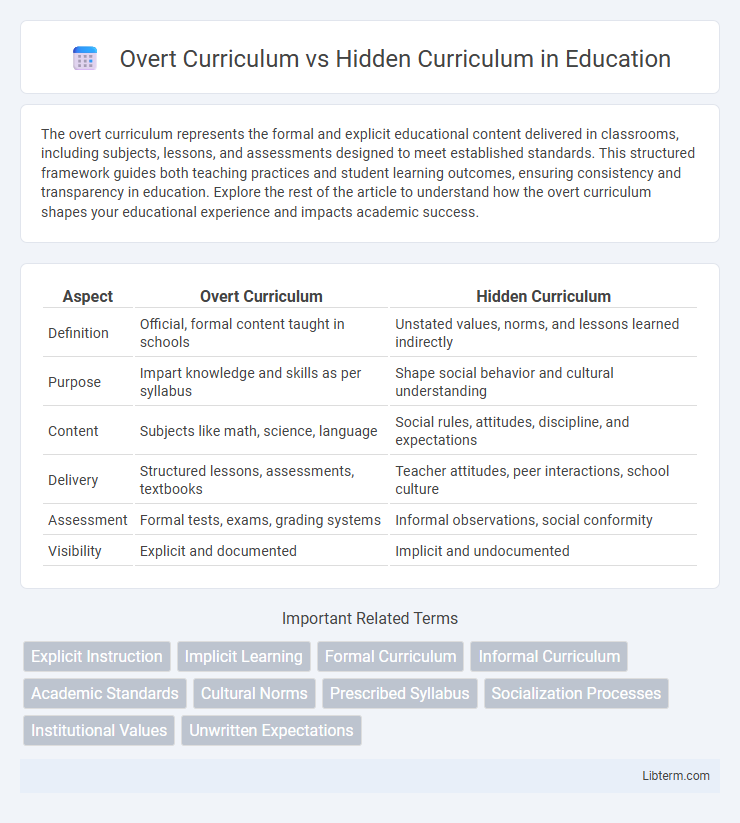The overt curriculum represents the formal and explicit educational content delivered in classrooms, including subjects, lessons, and assessments designed to meet established standards. This structured framework guides both teaching practices and student learning outcomes, ensuring consistency and transparency in education. Explore the rest of the article to understand how the overt curriculum shapes your educational experience and impacts academic success.
Table of Comparison
| Aspect | Overt Curriculum | Hidden Curriculum |
|---|---|---|
| Definition | Official, formal content taught in schools | Unstated values, norms, and lessons learned indirectly |
| Purpose | Impart knowledge and skills as per syllabus | Shape social behavior and cultural understanding |
| Content | Subjects like math, science, language | Social rules, attitudes, discipline, and expectations |
| Delivery | Structured lessons, assessments, textbooks | Teacher attitudes, peer interactions, school culture |
| Assessment | Formal tests, exams, grading systems | Informal observations, social conformity |
| Visibility | Explicit and documented | Implicit and undocumented |
Introduction to Overt and Hidden Curriculum
Overt curriculum refers to the formal, explicit educational objectives, content, and lessons that schools deliberately set out to teach students. Hidden curriculum encompasses the implicit lessons, values, and social norms conveyed through the school environment, teacher attitudes, and institutional culture. Understanding both overt and hidden curricula is essential for comprehending how education shapes student behavior and societal expectations beyond the official syllabus.
Defining the Overt Curriculum
The overt curriculum refers to the explicit, formally outlined educational content and objectives presented in textbooks, lesson plans, and standardized assessments. It encompasses the knowledge, skills, and competencies that schools intentionally aim to teach students during classroom instruction. This structured curriculum forms the foundation for instructional activities, ensuring measurable academic outcomes and alignment with educational standards.
Understanding the Hidden Curriculum
The hidden curriculum refers to the implicit lessons, values, and norms conveyed in educational settings beyond the official overt curriculum. It shapes student behavior, social skills, and attitudes through unspoken rules, teacher expectations, and institutional culture. Recognizing the hidden curriculum is essential for addressing inequalities and fostering inclusive learning environments.
Key Differences Between Overt and Hidden Curriculum
Overt curriculum refers to the explicit, formal educational content and objectives intentionally designed and delivered by schools, such as lesson plans, textbooks, and standardized assessments. Hidden curriculum encompasses the implicit lessons, values, and norms conveyed through the school culture, teacher attitudes, and peer interactions that are not formally documented but significantly influence student behavior and socialization. Key differences include the overt curriculum's clarity and intentionality versus the hidden curriculum's subtlety and unintentional impact on students' social and moral development.
Examples of Overt Curriculum in Education
Examples of overt curriculum in education include the prescribed lesson plans, standardized tests, and clearly outlined learning objectives found in textbooks and syllabi. This explicit curriculum covers subjects such as mathematics, science, language arts, and social studies, ensuring students acquire foundational knowledge and skills. Classroom activities like lectures, written assignments, and graded exams directly reflect the explicit goals set by educational institutions.
Examples of Hidden Curriculum in Schools
Hidden curriculum in schools includes unspoken values and social norms taught through students' everyday interactions, such as peer group behavior, teacher expectations, and school culture. Examples include learning punctuality through enforced schedules, understanding social hierarchy during lunch breaks, and internalizing gender roles via classroom dynamics. These implicit lessons shape students' attitudes and social skills beyond formal academic content found in overt curriculum.
Effects of Overt Curriculum on Student Learning
Overt curriculum, comprising the explicit educational content and structured learning objectives, directly impacts student learning by providing clear academic goals and measurable outcomes. This structured framework facilitates the acquisition of essential knowledge and skills, promoting cognitive development and subject mastery. Consistent implementation of overt curriculum enhances student motivation and engagement by outlining expectations and assessment criteria, leading to improved academic performance.
Impact of Hidden Curriculum on Behavior and Attitudes
The hidden curriculum profoundly influences student behavior and attitudes by transmitting implicit social norms, values, and expectations beyond the formal syllabus. These unspoken lessons shape interpersonal skills, conformity to institutional culture, and individual identity, often reinforcing societal inequalities and biases. Recognition of the hidden curriculum is crucial for educators aiming to foster inclusive environments and promote positive behavioral outcomes.
Addressing Hidden Curriculum in Educational Practice
Addressing the hidden curriculum in educational practice involves recognizing and actively managing the implicit lessons, values, and norms conveyed outside formal instruction. Educators should create inclusive environments that critically evaluate and mitigate biases embedded in social interactions, classroom dynamics, and institutional policies. Implementing reflective teaching strategies and promoting transparency ensures that hidden curriculum elements support equitable learning outcomes alongside overt curriculum goals.
Balancing Overt and Hidden Curriculum for Effective Learning
Balancing overt curriculum, which includes clearly defined academic content and objectives, with the hidden curriculum, encompassing implicit lessons such as social norms and values, is essential for effective learning. Incorporating both allows educators to foster cognitive skills alongside emotional intelligence and social responsibility, creating a well-rounded educational experience. Strategic integration of explicit instruction and subtle guidance enhances student engagement, motivation, and holistic development.
Overt Curriculum Infographic

 libterm.com
libterm.com